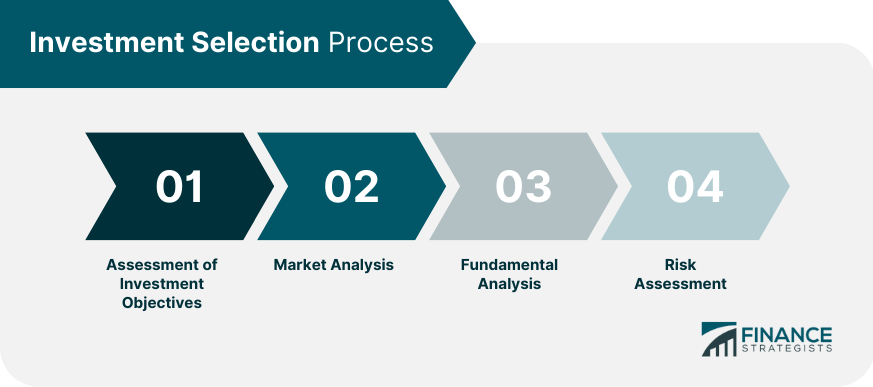Investment selection refers to the process of identifying and choosing investments that align with an individual's financial goals and risk tolerance. It involves considering factors such as historical performance, potential for growth, and risk level to make informed investment decisions. Investment selection is crucial because it can have a significant impact on the returns generated by an investment portfolio. Making the right investment decisions can help to maximize returns, while poor choices can lead to losses. A well-diversified portfolio with carefully selected investments can also help to manage risk and protect against market volatility. Moreover, the investment selection process should be based on a thorough analysis of various factors, including market trends, company performance, financial metrics, and risk-reward profiles. It requires a good understanding of investment options, such as stocks, bonds, mutual funds, ETFs, and alternative investments, and the ability to identify opportunities that align with an investor's goals, preferences, and risk tolerance. Overall, investment selection is critical for achieving long-term financial goals and should be approached with careful consideration and professional guidance if necessary. The investment selection process involves various stages that require careful consideration and analysis to make informed investment decisions. The first step in the investment selection process is to assess the investor's investment objectives, which could be long-term growth, income generation, or capital preservation. Understanding investment goals helps in determining the appropriate asset allocation, risk tolerance, and investment options that align with the investor's needs. The next step in the investment selection process is to conduct a market analysis to identify potential investment opportunities. This involves analyzing market trends, economic indicators, and industry-specific factors that could affect the performance of various investment options. A thorough market analysis can help investors to identify undervalued assets and avoid overvalued ones. Once potential investment opportunities have been identified, investors need to conduct a fundamental analysis of the companies or assets they are considering. Fundamental analysis involves evaluating various financial metrics, such as revenue, earnings, cash flow, and debt levels, to assess the intrinsic value of an investment. It also involves assessing the management team, competitive landscape, and future growth prospects of the company or asset. Investors need to assess the risk-reward profile of each investment opportunity to determine its suitability. This involves evaluating the level of risk involved, such as market risk, credit risk, and liquidity risk, and assessing the potential returns relative to the risk. A well-diversified portfolio should have a balance of low-risk and high-risk investments to manage overall portfolio risk. The time horizon is a critical factor to consider when selecting investments. Investors with longer time horizons, such as those investing for retirement, can generally afford to take on more risk and invest in higher-risk assets such as stocks or mutual funds. Conversely, investors with shorter time horizons may prefer lower-risk investments such as bonds or cash equivalents to avoid potential losses that could impact their immediate financial needs.. Liquidity is another essential factor to consider when selecting investments. Investments that are highly liquid, such as cash or short-term bonds, can be easily converted to cash without affecting their market value. This feature is especially important for investors who may need to access their funds quickly or unexpectedly, such as for emergencies or other unplanned expenses. Diversification is a strategy that involves spreading investments across various asset classes, industries, and regions to reduce overall portfolio risk. By diversifying their portfolio, investors can minimize the impact of individual investment losses and protect against market fluctuations. For example, a portfolio that includes a mix of stocks, bonds, and real estate investments can help mitigate risk and provide more stable long-term returns. Investors should consider the tax implications of their investments when selecting assets for their portfolio. Certain investments, such as stocks held for more than one year, may qualify for lower tax rates on capital gains. Tax-efficient investment strategies, such as investing in tax-advantaged accounts like IRAs or 401(k)s, can also help investors minimize the impact of taxes on their investment returns. Investment fees and expenses can have a significant impact on overall returns. Investors should consider the costs associated with investing, such as management fees, trading commissions, and fund expense ratios when selecting investments. By choosing low-cost investment options, investors can maximize their returns and keep more of their investment gains. While past performance does not guarantee future results, examining historical trends and potential growth prospects can help investors identify promising investment opportunities. Historical performance data can provide insight into an investment's volatility, risk, and overall performance, while potential growth prospects can help investors identify investments that are likely to generate high returns in the future. Investment selection is an essential aspect of building a successful investment portfolio. Making sound investment choices can help investors maximize returns and minimize risk. Before making any investment decisions, investors should define their investment goals. This includes determining their investment time horizon, risk tolerance, and financial objectives. By defining these goals, investors can choose investment options that align with their needs and help them achieve their financial goals. Diversification is a critical component of successful investing. By spreading investments across various asset classes, industries, and regions, investors can minimize the impact of individual investment losses and protect against market volatility. A well-diversified portfolio should include a mix of stocks, bonds, mutual funds, ETFs, and alternative investments. Investing in quality companies is another essential tip for making wise investment selections. Quality companies are those with a strong track record of financial performance, excellent management, and a competitive advantage in their industry. By investing in these companies, investors can generate long-term returns and minimize the risk of significant losses. Investors should conduct thorough research before making any investment decisions. This includes analyzing market trends, examining historical performance data, and evaluating potential risks and opportunities. By doing their due diligence, investors can make informed investment decisions and minimize the risk of significant losses. Investing can be complex, and it is essential to seek professional guidance when making investment decisions. Financial advisors and investment professionals can provide expert advice on investment selection, portfolio management, and risk management. By working with a professional, investors can maximize their returns and minimize the risk of significant losses. Investment selection plays a critical role in achieving financial success and security. By understanding personal financial goals, risk tolerance, and the various types of investments available, investors can make informed decisions and create a personalized investment strategy. Regular monitoring and adjustment of one's investment portfolio and consideration of factors such as diversification, tax implications, and fees are essential for optimizing returns and managing risk. Ultimately, a thoughtful approach to investment selection will help individuals progress towards their financial goals and build a solid foundation for long-term financial stability.What Is Investment Selection?
Importance of Investment Selection
Investment Selection Process
Assessment of Investment Objectives
Market Analysis
Fundamental Analysis
Risk Assessment

Factors to Consider When Selecting Investments
Time Horizon
Liquidity
Diversification
Tax Implications
Management Fees and Expenses
Historical Performance and Potential Growth
How to Make a Sound Investment Selection
Define Investment Goals
Diversify Your Portfolio
Invest in Quality Companies
Do Your Research
Seek Professional Guidance

Conclusion
Investment Selection FAQs
Investment selection refers to the process of identifying and choosing investments that align with an individual's financial goals and risk tolerance.
Investment selection is a crucial aspect of investing because the quality of the investments chosen largely determines the performance of an investment portfolio.
Some key factors to consider when selecting investments include the investment's historical performance, potential for growth, risk level, and how well it aligns with your investment objectives.
Yes, diversification is an essential aspect of investment selection because it helps to spread risk across different investments, reducing the impact of any one investment's poor performance.
Yes, many investment selection tools and apps are available that use algorithms and data analysis to help investors choose investments that are likely to meet their objectives and risk profile.
True Tamplin is a published author, public speaker, CEO of UpDigital, and founder of Finance Strategists.
True is a Certified Educator in Personal Finance (CEPF®), author of The Handy Financial Ratios Guide, a member of the Society for Advancing Business Editing and Writing, contributes to his financial education site, Finance Strategists, and has spoken to various financial communities such as the CFA Institute, as well as university students like his Alma mater, Biola University, where he received a bachelor of science in business and data analytics.
To learn more about True, visit his personal website or view his author profiles on Amazon, Nasdaq and Forbes.













